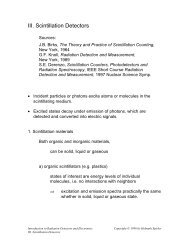Introduction to radiation-resistant semiconductor devices and circuits
Introduction to radiation-resistant semiconductor devices and circuits
Introduction to radiation-resistant semiconductor devices and circuits
Create successful ePaper yourself
Turn your PDF publications into a flip-book with our unique Google optimized e-Paper software.
een calculated over a large energy range. (4) Although not verified quantitatively,<br />
these curves can be used <strong>to</strong> estimate relative effects. X-rays do not cause direct<br />
displacement damage, since momentum conservation sets a threshold energy of<br />
250 keV for pho<strong>to</strong>ns. 60 Co γ rays cause displacement damage primarily through<br />
Comp<strong>to</strong>n electrons <strong>and</strong> are about three orders of magnitude less damaging per<br />
pho<strong>to</strong>n than a 1 MeV neutron. (5) Table 1 gives a rough comparison of displacement<br />
damage for several types of <strong>radiation</strong>.<br />
Particle pro<strong>to</strong>n pro<strong>to</strong>n neutron electron electron<br />
Energy 1 GeV 50 MeV 1 MeV 1 MeV 1 GeV<br />
Relative<br />
Damage<br />
1 2 2 0.01 0.1<br />
TABLE 1. Relative displacement damage for various particles <strong>and</strong> energies.<br />
Displacement damage manifests itself in three important ways:<br />
• formation of mid-gap states, which facilitate the transition of electrons from<br />
the valence <strong>to</strong> the conduction b<strong>and</strong>. In depletion regions this leads <strong>to</strong> a generation<br />
current, i.e. an increase in the current of reverse-biased pn-diodes. In<br />
forward biased junctions or non-depleted regions mid-gap states facilitate<br />
recombination, i.e. charge loss.<br />
• states close <strong>to</strong> the b<strong>and</strong> edges facilitate trapping, where charge is captured <strong>and</strong><br />
released after a certain time.<br />
• a change in doping characteristics (donor or accep<strong>to</strong>r density).<br />
The role of mid-gap states is illustrated in Fig. 1. Because interb<strong>and</strong> transitions<br />
in Si require momentum transfer (“indirect b<strong>and</strong>-gap”), direct transitions between<br />
the conduction <strong>and</strong> valence b<strong>and</strong>s are extremely improbable (unlike GaAs, for<br />
example). The introduction of intermediate states in the forbidden gap provides<br />
“stepping s<strong>to</strong>nes” for emission <strong>and</strong> capture processes. The individual steps,<br />
emission of holes or electrons <strong>and</strong> capture of electrons or holes, are illustrated in<br />
Fig. 1. As shown in Fig. 1a, the process of hole emission from a defect can also be<br />
viewed as promoting an electron from the valence b<strong>and</strong> <strong>to</strong> the defect level. In a<br />
second step (1b) this electron can proceed <strong>to</strong> the conduction b<strong>and</strong> <strong>and</strong> contribute<br />
<strong>to</strong> current flow, generation current. Conversely, a defect state can capture an<br />
4





